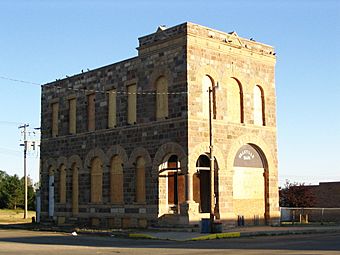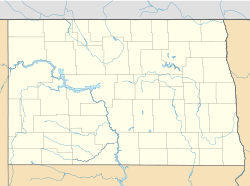Granville State Bank facts for kids
Quick facts for kids |
|
|
Granville State Bank
|
|
 |
|
| Location | Main and 2nd Sts., Granville, North Dakota |
|---|---|
| Area | less than one acre |
| Built | 1903 |
| Built by | Bill Horton; Robert Fowler |
| Architect | James S. Cox |
| Architectural style | Richardsonian Romanesque |
| NRHP reference No. | 77001509 |
| Added to NRHP | September 13, 1977 |
The Granville State Bank building, also known as the Former Granville Service Agency, is an old and interesting two-story building. It stands on Main Street in Granville, North Dakota. This special building was constructed in 1903.
Contents
Exploring the Granville State Bank Building
The Granville State Bank building was built by George E. Stubbins. He was the president of the Granville State Bank at the time. The building was made using strong materials. These included sandstone and prairie granite. These materials came from Kottke Valley Township nearby.
A Look at Its History
The building became a bank in 1929. It was home to the Granville State Bank until 1941. Before that, from 1903 to 1929, it was used by state banking officials. They worked there to check on banks. After the bank closed, a company that sold farm equipment, called International Harvester, used the building for a while.
Who Designed This Building?
The person who designed this building was an architect named James S. Cox. He was from Estherville, Iowa. James S. Cox also designed another important building. This was the Grand Auditorium and Hotel Block in Story City, Iowa.
What is Richardsonian Romanesque Architecture?
The Granville State Bank building is a great example of something called Richardsonian Romanesque architecture. This style was popular in the late 1800s. It often uses heavy stone walls and round arches. Buildings in this style look very strong and solid. They often have a castle-like feel.
A Special Place in History: National Register
In 1977, the Granville State Bank building was added to the National Register of Historic Places (NRHP). This is a list of places in the United States that are important to history. Being on this list helps to protect the building. It means the building is recognized for its historical value.
Where Did the Bank's Old Stuff Go?
The bank building used to have beautiful wooden fixtures inside. These were like special decorations and furniture. In 1973, these fixtures were moved. They went to a bank museum. This museum is located at the Divide County Pioneer Village in Crosby, North Dakota. It's a way to preserve a piece of the bank's past.



